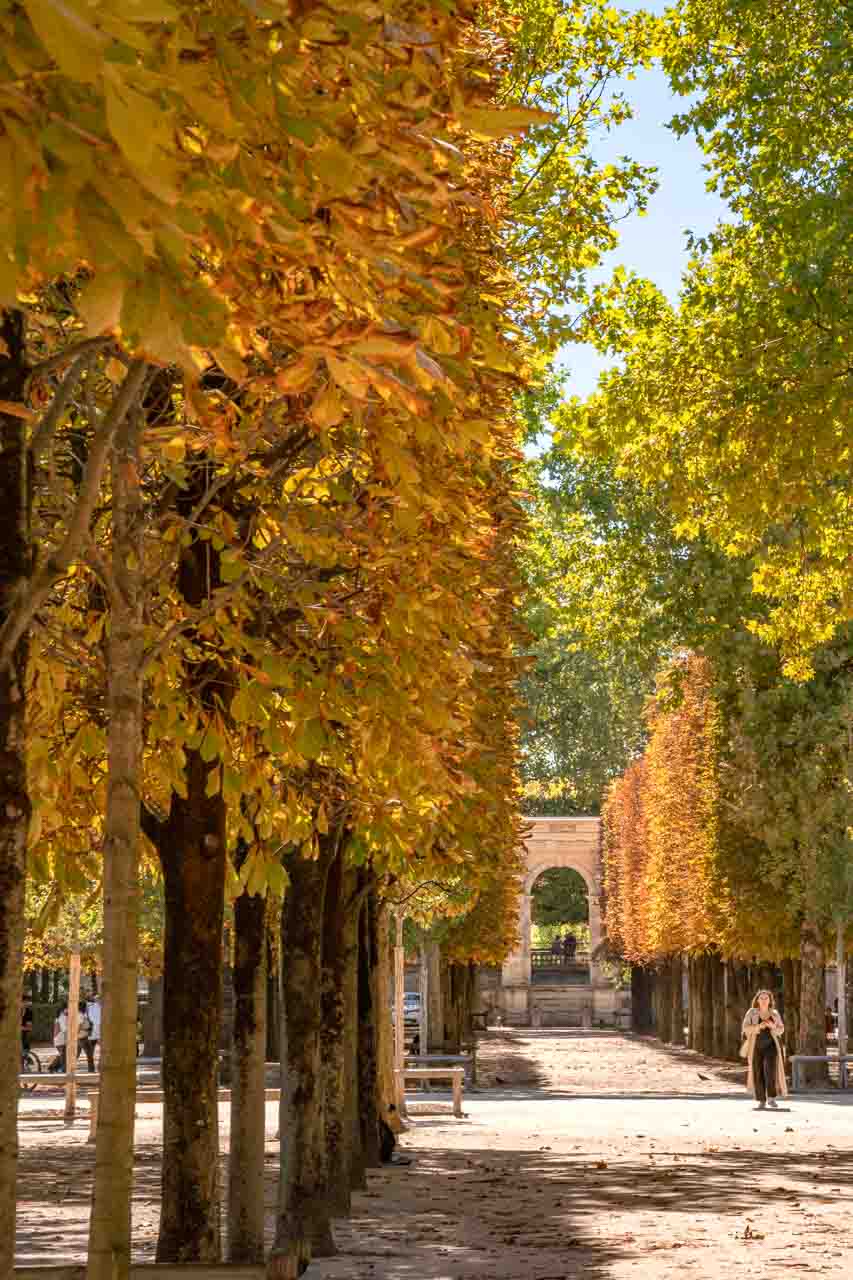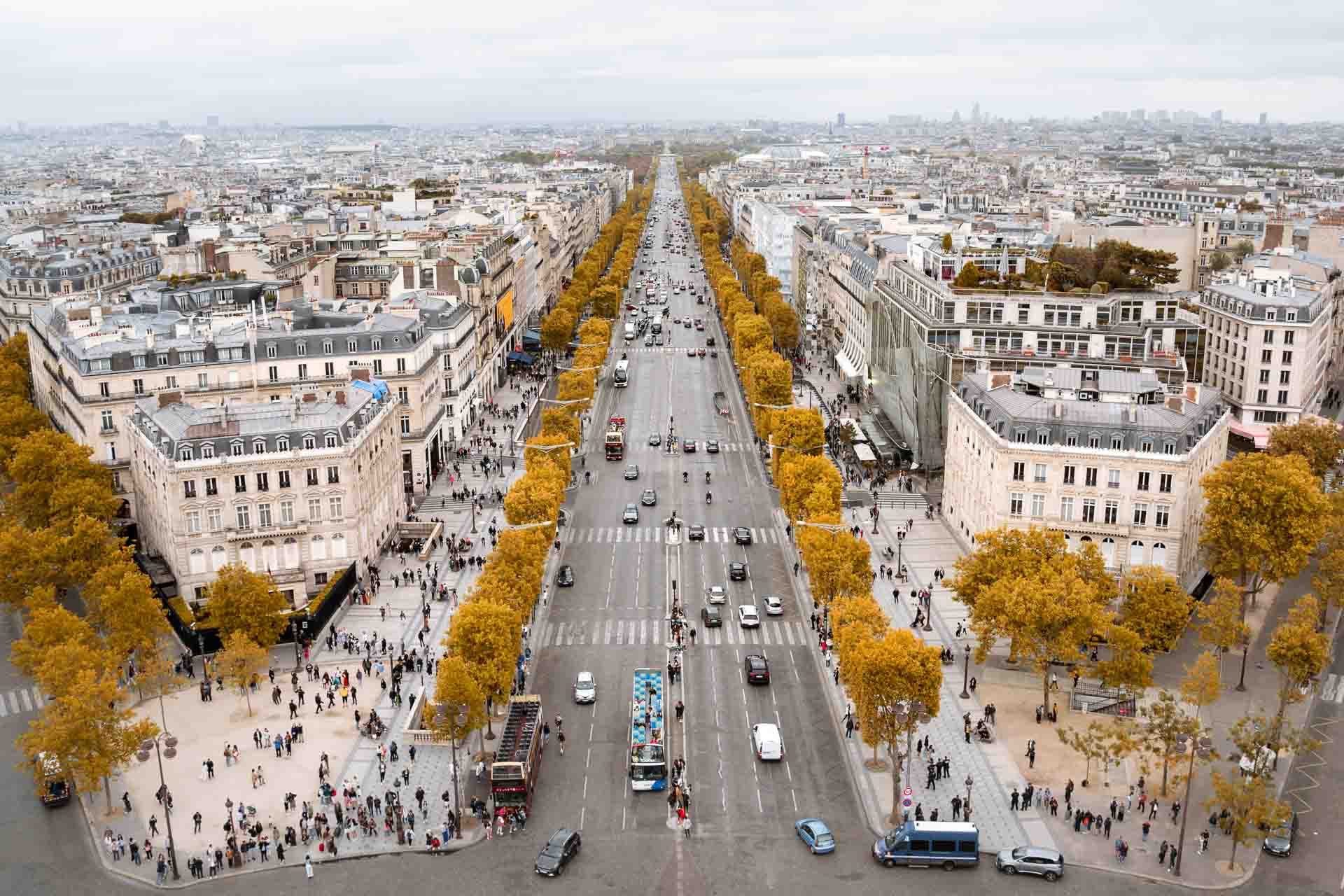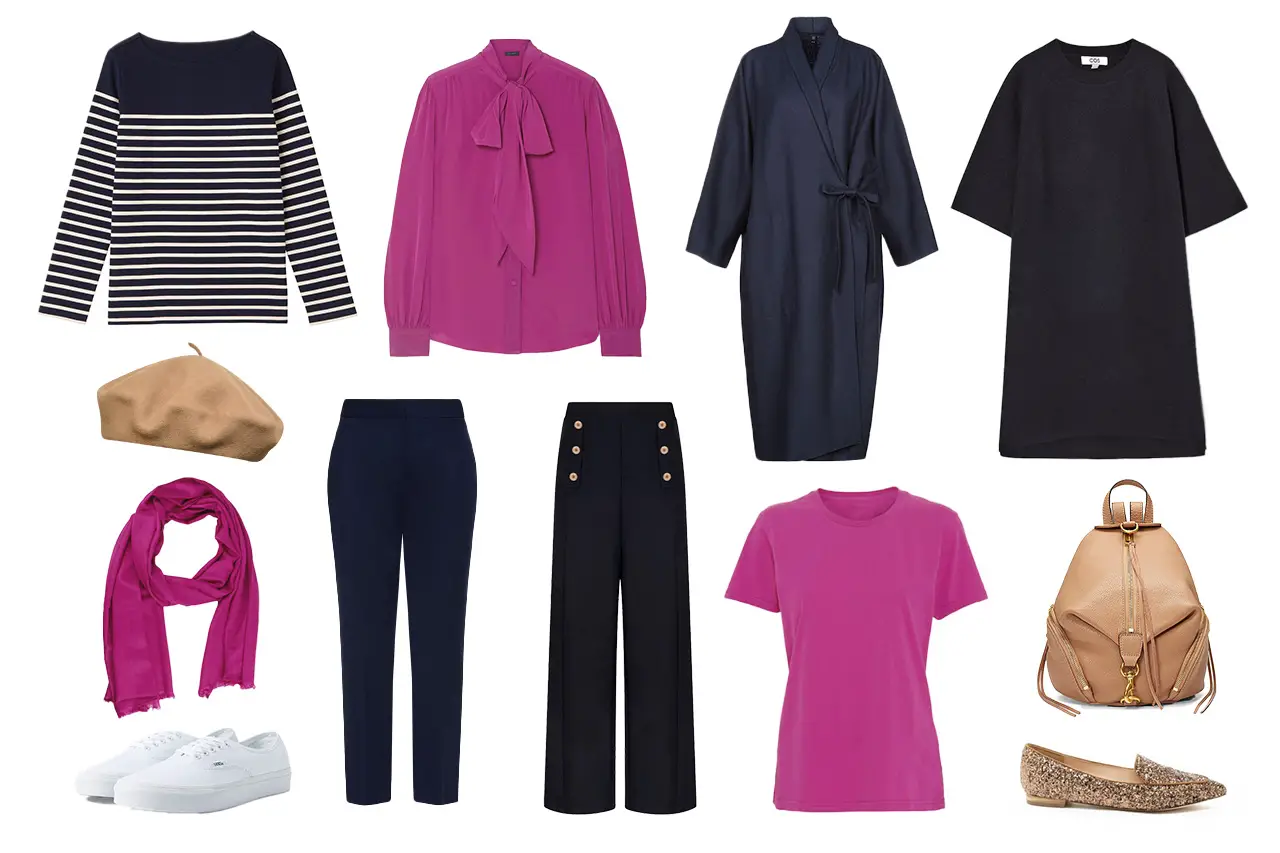Choosing to visit Paris in autumn is easy—I mean, Paris is always a good idea, right!? In the autumn months–late September to late December—the weather is cooling and tourist crowds are ebbing leaves. In the earlier months, leaves are turning brilliant hues and if you’re late in the season, the magical Christmas markets are starting. But choosing what to wear in Paris during this transitional season can be a little tricky, so let me be your guide you. Learn what to pack for Paris in autumn with the following tips. Plus, download my printable checklist at the end of this post.
General packing tips for Paris
Climate
Generally, weather in Paris is largely influenced by its proximity to the Atlantic Ocean. This moderates the climate keeping it quite temperate, though at times, it may still experience more Continental extremes of hot and cold. Rain at low levels is fairly consistent throughout the year, with a slight dip in summer. Winters are cloudy, rainy and windy with occasional snow in winter. Since Autumn in Paris can range from late-summer weather to more winter-like, here is a breakdown of each month:
September
Autumn in Paris begins in late September, when the weather becomes more unstable, temperatures drop, clouds gather and more consistent rain returns. Late September temperatures range from 10-20°C (about 51-68°F) and the chance of a wet day is about 24%.
October
October in Paris sees temperatures drop further. Daily temperatures in early October range from about 10-19°C (50-66°F), while in the later part of the month they range from 7-14°C (44-56°F). The chance of rain is pretty even throughout the month, around 25%.
November
Temperatures continue to descend, with an average range of 7-14°C (44-56°F) at the beginning of the month and 3-9°C (37-48°F) at the end. The chance of rain throughout November is consistently 26%.
December
December temperatures start out where November leaves off at about 7-14°C (44-56°F) and fall to an range of about 2-7°C (36-45°F). The chance of rainfall is 26% at the start of the month, increasing to 30% by the end. December has the highest number of wet days, with an average of 13 days seeing rainfall.
Clothing and comfort
Paris is a very walkable destination, so expect to work up a sweat at times, even on a cooler day. Pack lightweight, layerable pieces that will allow you to adjust to changing temperatures.
One water resistant outwear piece is good for rainy days, and make sure it is long (at least to your knees) and has a hood or pack a separate rain hat. I am not a proponent of umbrellas in tight sometimes crowded city streets.
Down is a poor choice for rainy environments unless it’s encased in a completely waterproof outer layer. Once wet, down never performs as well thermally. Cotton is also not ideal, especially for garments like socks that might get wet. Wool is a great option as water tends to bead on its surface.
Currency
The Euro (EUR or €) is the official currency of France. Note that prices are written a little differently in France and broader Europe. A comma or the Euro symbol are used to separate Euros and cents, where in English we would use a decimal point. For instance, $9.99 in English is €9,99 or 9€99 in France.
Withdrawing local currency from an ATM on the ground can be the best option for getting a favourable international currency conversion rate. Paris is a fairly card-friendly city, however most ticketing machines such as those for public transport, require a card with a chip. If your credit card does not have a chip, then you will need to carry some cash with you. If you are doing day trips out of Paris, it is also a good idea to carry some cash.
Etiquette
The French have a reputation for being rude, but really this is not the case. If you take the time to understand some simple, foundational cultural differences and make an effort to bridge the gap, you’ll find most French people are quite friendly and hospitable.
- French culture is formal, especially when compared with the modern UK, USA or Australia.
- French people generally do not strike up conversations with strangers. It’s not unfriendly, they just culturally keep to themselves. Introverts, like me, will be in heaven!
- Always begin by greeting someone, no matter what your interaction is: bonjour during the day and bonsoir in the evening.
- Basic manners apply. S’il vous plait for please and merci or merci beaucoup for thank you.
- Speaking, or just attempting to speak a little French goes a long way. Watch or listen to this terrific, 1-hour, French language for travel video by the team at Rick Steves and it will feel a whole lot less intimidating. Give it a go!
Electronics
Electricity in France is delivered at 230 volts, 50Hz. Depending on where you are travelling from and what kind of appliances you are bringing, you may need a voltage converter. Generally, modern phones, tablets and laptops are made for both 110-127V and 220-240V, but it is best to check or you will ruin your appliance or device. France uses type C and E plugs, so you will almost certainly need an international adaptor.
Environment
Consider the environment and minimise packaging and disposables as much as possible – these guides have some practical suggestions: 8 Essential Eco-Friendly Travel Products and 5 Steps to More Sustainable Travel.
You can drink the tap water in Paris, and there are water refill stations around the city to discourage people from using single-use plastic bottles. Some water fountains even deliver sparkling water! Don’t pay for something you can get for free, pack a reusable water bottle for Paris.
Depending where you live or travel regularly, some of the things I recommend you pack for Paris may not be part of your existing wardrobe. Consider borrowing and/or thrifting items to fill the gaps, if there is something you need. I share my sustainable sources for travel clothing here.
Passport and visas
Ensure your passport has at least 6 months validity and plenty of pages for your new passport stamps. Check whether you require a visa for entry into France – it will depend on the country of your passport.
Security
Pickpocketing and petty theft are common in the train/buses and frequently touristed areas. Pickpockets commonly work in gangs, where one will distract you while the other swipes you wallet, so be vigilant.
Keep your valuables to a minimum, secure those you must take and don’t flash them around. Ensure your bag is zipped up and within reach at all times. Crossbody style bags are preferable, as they can’t be easily pulled off your shoulder. Thieves have been known to slash bags to get at their contents or cut the strap to remove them entirely.
Don’t leave your phone or wallet sitting visible on a tabletop, even if they are right in front of you – they are easily snatched by a passerby. Also, don’t stand close to the roadside using your phone, step back from the curb, out of reach of passing snatchers on bicycles. See this post for general travel security tips.
Tipping
Tipping in restaurants is appreciated but not expected – staff make a monthly salary and a service charge is regularly included which indirectly benefits staff. A customary tip of 5-10% is adequate for exceptional service. For taxi drivers, €1-2 will do unless you have a long ride or heavy bags. For hotel bellhops or a helpful concierge, tip €1-4 and €24 per night for housekeeping. Gratuities for tour guides are typically in the realm of €2-5 per day for group guides or €10-20 for private guides. Tip half that for the tour driver, if there is one.
Travel insurance
Never leave home without travel insurance. Especially in this post-pandemic world where everything is still a little dysfunctional and the tourism industry is finding its feet again. See some of our travel disasters and travel insurance tips in this post.





What to wear in Paris
Parisians tend to be well dressed, combining classics with a little bit of edge. Dress nicely for restaurants, which means no jeans or sneakers. Rather, chinos or tailored trousers and a pair of dressier shoes like brogues or boots. Also, dress more conservatively for religious sights.
If you want to avoid looking like a tourist which makes you a target for pickpockets and other unscrupulous types, leave your shorts, baseball caps, neon and activewear at home. Yeah, I totally wore a beret, Breton stripes and sailor pants in Paris. Just not all-together. Parisians where them too, again, not all at once. Looking like a walking, talking stereotype will also highlight your tourist status.
Clothing and accessories
- Underwear, bras and socks – pack just a week’s worth and wash in the shower or bathroom sink. Remember to choose warm, water resistant socks and bring plenty. I’m a big fan of these Merino wool socks by Smartwool, as they are warm and have extra cushioning that is great for trips where I’ll be doing a lot of walking.
- Sleepwear – including sleep mask and earplugs.
- Base layer – In November through December, a base layers/long johns/thermal underwear is a really good idea. I like Merino wool, but you can get base layers in silk, cotton and synthetics also. They are especially great as a layer under your jeans or pants which can be harder to layer.
- Shirts – pack a long sleeve shirt for every 2-3 days of your trip. Button-ups, blouses and knits are ideal things to wear in Paris
- Sweaters – 2-3 layerable sweaters.
- Pants – pack 2-3 pairs of long pants or jeans. I chose a combination of jeans for casual sightseeing and a pair of tailored pants for dinners and dressier occasions.
- Outerwear – A light coat such as a classic trench will be fine for September, but you will need something increasingly warm and waterproof as autumn progresses. If your rain jacket is separate from your warm coat, make sure it fits over the top.
- Rain jacket or poncho – Fall in Paris means rain often accompanied by wind, so choose a longer length rain coat rather than an umbrella.
- Shoes – depending on the activities you have planned, you need a pair of comfortable walking shoes and a nicer pair for evening activities. I recommend Gore-Tex (waterproof) shoes or giving your chosen pairs a thorough waterproofing treatment before you pack them.
- Also, note cobblestones are common in Paris, therefore heels are not a good idea. A nice pair of brogues or Chelsea boots are better for the colder months.
- Sunglasses – UV rated to protect your eyes and polarizing to cut glare.
- Accessories – jewellery (preferably costume jewellery for security) or other accessories to dress up an outfit in the evening. You will see a lot of Parisians wear scarves.
- Hat – a warm hat to keep your noggin dry and toasty.
Toiletries
- Deodorant
- Toothpaste and toothbrush
- Shampoo and conditioner
- Face wash
- Body wash
- Moisturiser
- Hair accessories (ties and pins)
- Menstrual products
- Makeup and perfume
- Laundry soap – a cake of laundry soap is great for washing your smalls in the hotel basin and doesn’t add to your liquid/powder count if you’re travelling carry-on only.
Gadgets
- Camera – along with accessories such as charger, spare batteries; SD cards; and tripod.
- Phone – including accessories such as a charger.
- International adaptor
- Portable power bank – particularly if you are using your phone as a camera.
Day bag
- Refillable water bottle
- Hand sanitizer
- Face mask – most places do not require face masks any longer, but it is good to have one just in case.
- Headphones
- Medications and prescriptions
- Sunscreen or makeup with SPF 15+ or higher
- Lip balm with SPF 15+
- Money belt – alternatively a bra pouch or other secure wallet.
- Guidebook
Making memories and filling spare time
- Book
- Sketch pad and pencils/paint
- Notebook or diary
- Tablet device

What’s in my suitcase
Here are the key items I packed for Paris in autumn. Note my trip was in mid to late September.
- Muji, long sleeve, cotton, breton shirt.
- Marc Jacobs fuschia, silk blouse.
- Eileen Fischer light, wool coat – thrifted.
- COS merino wool dress.
- Kangol beret that belonged to my grandmother. I also purchased Laulhère berets in Paris as a souvenir of my trip.
- Scarf, unknown brand – thrifted.
- Vans white tennis shoes. A risky choice for autumn. Darker coloured shoes are better.
- Cotton ankle pants, brand unknown – thrifted.
- Saint + Sofia sailor pants.
- Pact cotton tee.
- Rebecca Minkoff leather backpack.
- Sole society sparkly smoking slippers.
I hope this guide helps you decide what to wear in Paris in fall and has simplified packing for your sojourn in the City of Light. Let me know in the comments below how you faired. Also, see this international travel checklist for additional pre-departure considerations, along with these things travellers often forget!
Peace, love & inspiring travel,
Madam ZoZo




